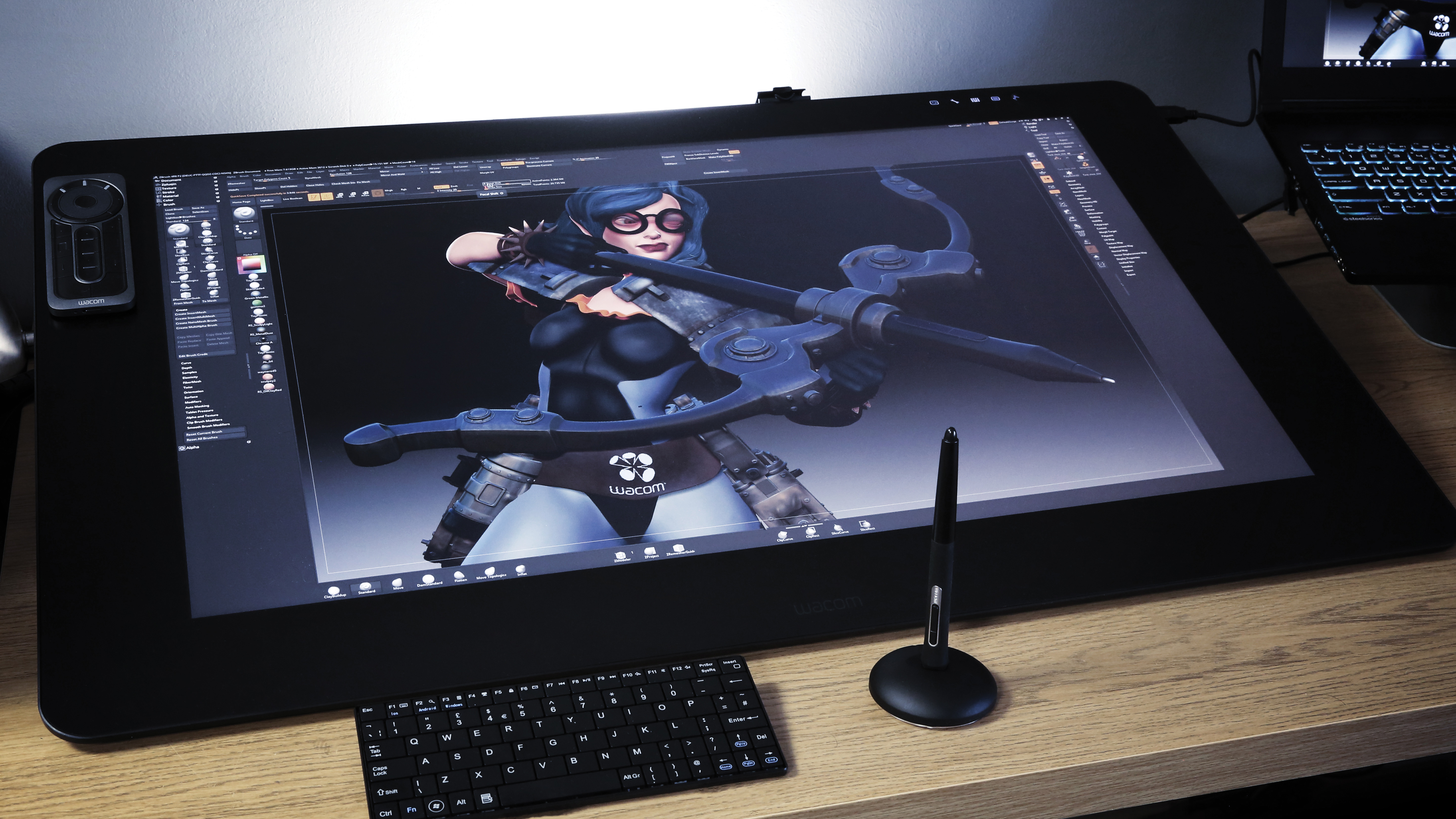Our Verdict
Providing both a larger screen and UHD ready resolution, the Wacom Cintiq Pro 32 is the upgrade users have been waiting for.
For
- 4K UHD display
- Touch functionality
- Larger screen size
Against
- Ergo Stand supplied separately
Why you can trust Creative Bloq
If you've have the chance to use one of Wacom’s large-format pen displays, you'll know why these drawing tablets are used in studios around the world.
Wacom’s previous flagship model, the Cintiq 27QHD, provided artists with an impressive 27 inches of screen space at a resolution of 2,560 x 1,400 pixels. As the push for Ultra High Definition content increases, however, artists are beginning to need more resolution and screen space than ever before.
Step up the Wacom Cintiq Pro 32. It isn't yet on sale – but we got our hands on the latest model in Wacom’s Cintiq family to give it a spin...
Wacom Cintiq Pro 32: specs
The Wacom Cintiq Pro 32 features a 4K UHD display spanning an impressive 32 inches, with a resolution of 3,840 x 2,160 pixels. With four times the pixels of a standard 1080p display, the Cintiq Pro 32 provides plenty of work space, allowing users to display important toolbars without eating into that precious screen space.
Wacom Cintiq Pro 32: display
Unlike the Wacom Cintiq Pro 24 (another new release) and previous generation Cintiqs, which came in touch and non-touch variants, the Wacom Cintiq Pro 32 comes with touch functionality as standard. Despite the larger screen, the Cintiq Pro 32 is only 8.5cm wider and 4cm taller but uses a smaller bezel, meaning more screen space without taking over too much desk.
Both Cintiq Pro models come with Wacom’s Pro Pen 2, featuring 8,192 levels of sensitivity, plus tilt-response for a more natural and virtually lag-free drawing experience. The displays also come with the ExpressKey Remote, a controller that houses the buttons and touch ring commonly found along one edge of the earlier Cintiq models.
The separation of this remote from the main body of the display allows for seamless switching between left and right-handed modes, and the non-slip backing means the remote can be placed anywhere on the face of the device, with magnetic strips down either side to hold the remote in place when the display is positioned vertically.

In order to rotate the display more freely, the optional Ergo Stand is required. This allows the display to be set vertically like a standard monitor, and horizontally at standing height or desk level. Out of the box, the back of the display features two fl ip-out legs to support the device at a 20-degree angle to the desk.
Reducing glare
When used in a bright studio environment, glare may present an issue. Compared to the 27QHD, which has a more reflective screen coating, the Pro 32 has taken steps towards solving this issue with an etched glass screen that diffuses those harsh reflections.
This is also helped by turning off room lighting and using a desk light, or by using the Ergo Stand to angle the device away from the light source.
Connectivity
Towards the rear of the display, there is a panel which can be removed to reveal the various ports and sockets used to connect your display to your work machine. These include:
- 1x HDMI
- 1x DisplayPort
- 1x USB Type-C
- 1x USB 3.0
- 1x Power socket
With four times the pixels of a standard 1080p display, users to display important toolbars without eating into precious screen space.
Glen Southern
Located around the side edges of the display are four USB 3.0 ports, with two on either side for device connectivity such as charging the ExpressKey Remote. There is also a 3.5mm headphone jack on the left side and a SD card VERDICT slot at the right, both located under the USB ports.
At the top edge of the display is the power switch and LED power indicator. On the top left above the screen, there is a series of touch buttons that enable you to call various functions from your machine such as the on-screen keyboards, access Wacom settings or enable and disable the touch function.
Extra space
There is also a button that enables toggling between the display input mode for the device which was absent from the 27QHD, meaning cables no longer have to be swapped between machines. In the studio, we have a USB-C enabled laptop plugged in via the included USB-C cable, with a workstation plugged into the display through a USB 3.0 and DisplayPort cable. This means machines can be swapped with the press of a button and with no rummaging around under the desk.
The use of the USB-C for this generation greatly reduces cable clutter, as both the display signal and USB connectivity can be run through one cable. Unlike the Cintiq MobileStudio Pro, the Pro 32 does not feature any external USB-C ports, which will be welcomed by those who are unprepared to upgrade all of their devices to USB-C.The Cintiq Pro 32 offers a large screen size, with the resolution perfect for displaying UHD content.
The extra space is also ideal for users who require specific toolbars and custom user interface layouts without limiting canvas or viewport size. Additionally, there is also the option to transform your Cintiq Pro into a powerful standalone creative pen computer with the Wacom Cintiq Pro Engine PC module.
The Wacom Cintiq Pro 32 is due to ship in Spring 2018.
This article was originally published in issue 233 of 3D World, the world's best-selling magazine for CG artists. Buy issue 233 here or subscribe here.
Also read: The best cheap Wacom tablet deals

Thank you for reading 5 articles this month* Join now for unlimited access
Enjoy your first month for just £1 / $1 / €1
*Read 5 free articles per month without a subscription

Join now for unlimited access
Try first month for just £1 / $1 / €1
out of 10
Providing both a larger screen and UHD ready resolution, the Wacom Cintiq Pro 32 is the upgrade users have been waiting for.

Glen runs SouthernGFX, a small Cheshire-based studio specialising in character and creature design, which creates assets for TV and film. Clients include SKY, Wacom and Oculus Medium and the studio has an impressive project list that features 3D models for Game of Thrones' house sigils. He's been using and training ZBrush for over 15 years and is a Wacom Ambassador for the UK and Ireland.


